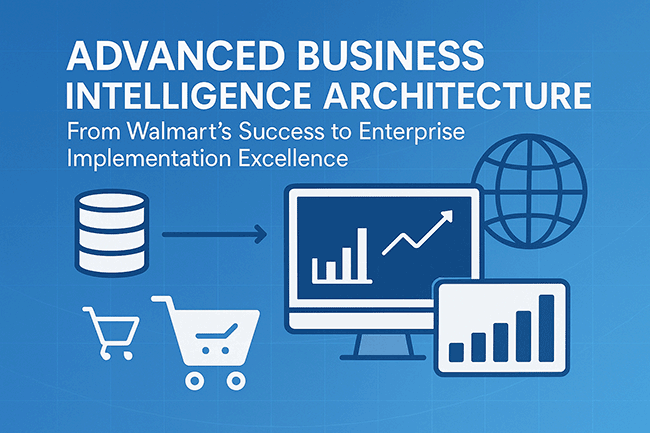Advanced Business Intelligence Architecture: From Walmart’s Success to Enterprise Implementation Excellence

Data Business Intelligence: A Comprehensive Case Study from USA - Walmart Inc.
In 2024, Walmart Inc. revolutionized its supply chain operations through a comprehensive Business Intelligence transformation, establishing new benchmarks for enterprise analytics in American retail. This groundbreaking implementation demonstrates how Fortune 500 companies leverage modern BI architectures to drive operational excellence and competitive advantage.
Implementation Architecture
Walmart deployed a hybrid cloud infrastructure utilizing Microsoft Azure Synapse Analytics as their primary data warehouse, processing over 2.5 petabytes of transactional data daily. The architecture incorporates real-time streaming analytics through Apache Kafka clusters with 99.99% uptime SLA, enabling instantaneous inventory optimization across 10,500+ locations.
The company implemented federated data governance using Collibra Data Intelligence Platform, ensuring GDPR compliance and SOX regulatory adherence. Their master data management (MDM) strategy consolidates customer, product, and supplier information through Informatica MDM Hub, creating a 360-degree enterprise view.
Advanced Analytics Integration
Walmart's BI ecosystem leverages machine learning pipelines built on TensorFlow Extended (TFX) for demand forecasting, achieving 15% improvement in inventory turnover. The platform utilizes AutoML capabilities through Google Cloud Vertex AI, enabling business analysts to deploy predictive models without extensive data science expertise.
Natural Language Processing (NLP) implementation using spaCy libraries processes customer feedback across omnichannel touchpoints, generating actionable insights for product development teams. The system analyzes sentiment analysis patterns with 92% accuracy, driving customer experience optimization strategies.
Performance Metrics and ROI
The BI transformation delivered quantifiable business outcomes: $2.3 billion annual cost savings through optimized logistics, 40% reduction in stockouts, and 25% improvement in supplier performance metrics. The platform processes 50 million queries daily with sub-second response times, supporting 150,000+ concurrent users across global operations.
Self-service analytics adoption reached 78% across business units, reducing IT backlog by 60% and accelerating decision-making cycles. The implementation of data democratization strategies empowered non-technical users to create sophisticated reports using guided analytics workflows.
Technology Stack Innovation
Walmart's modern data stack includes Snowflake for data warehousing, dbt Core for transformation logic, and Apache Airflow for orchestration. The company pioneered DataOps methodologies with CI/CD pipelines for analytics code deployment, ensuring version control and automated testing across development lifecycles.
Edge computing integration through Azure IoT Edge enables real-time analytics at store locations, processing RFID sensor data and computer vision algorithms for inventory management. This distributed architecture reduces network latency and ensures operational continuity during connectivity disruptions.
The success of Walmart's BI transformation establishes a replicable framework for American enterprises seeking data-driven competitive advantages in increasingly complex market environments.